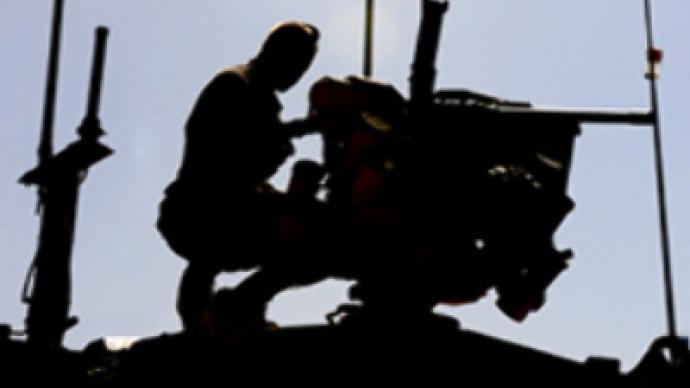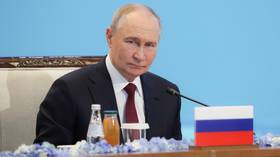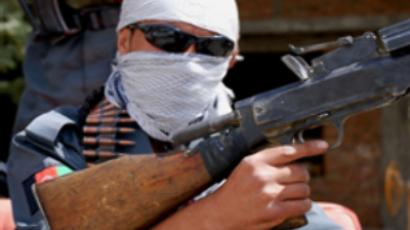The global financial crisis and NATO's commitment to Afghanistan

An analysis of the impact of the global financial crisis on NATO’s operations in Afghanistan shows that the economy is inextricably linked to security, with social conflict remaining a key issue for Alliance countries.
Despite the global financial crisis NATO has reaffirmed its long-term commitment to Afghanistan at its Brussels and the Bucharest summits this year.
“We will be in Afghanistan for as long as it takes,” NATO spokesperson Brigadier-General Richard Blanchette said. “Our goal is not an end date, but an end state.”
The Alliance is engaged in a highly complex struggle in Afghanistan in which it hopes to provide sufficient security for the rehabilitation of the Afghan state, civil society and economy.
“In a country as undeveloped as Afghanistan, the developmental work will never be finished,” according to Michael Clark, Director of the Royal United Services Institute for Defense and Security Studies (RUSI). He added: “New money cannot be spent until governance is addressed in Afghanistan, and governance cannot be addressed without significant amounts of new money.”
NATO’s role is a key part of the Afghanistan Compact – a five year plan between the Government of Afghanistan, and the international community, which sets goals relating to security, governance and economic development of the country.
“We can’t have a long-term economic goal in Afghanistan without security,” says Mr. John Coppard, NATO political analyst and Senior Civilian Representative to Afghanistan, “This is why NATO has a political interest.”
Brigadier-General Blanchette pointed out that the relationship between security, governance, and economic and social development – the three interdependent “pillars” identified by the Compact – increases the potential for involving the international community.
“This assures new interests,” he said. “NATO is cooperating with authorities on all levels to implement ‘windows of security’ of which the holding faze is the most important. For the holding faze we rely on the Afghan National Army. It makes it more difficult for the insurgents to come back.”
According to an Integrated Regional Information Networks (IRIN) report “humanitarian experts are looking at patterns of past recessions and economic slowdowns for guidance, and projections vary depending on aid agencies and their sources of funds.”
As far as official development aid is concerned, not everyone foresees a major decline. U.S. funding rose in both 2001 and 2002, despite an eight-month recession in 2001, linked to the dot.com bust. No UN agency has yet reported a slowdown in contributions, and no clear idea has yet been formed on the potential impact.
Some governments, such as the U.S. and Canada, are pledging to stand by their commitments to Afghanistan.
U.S. officials developed the concept of Provincial Reconstruction Teams (PRTs) in 2002 to help the U.S. military refocus its effort on stabilization and reconstruction. NATO operates in Afghanistan under the UN mandated International Security Assistance Force (ISAF). In 2004, it adopted the PRT model offering the possibility for coalition militaries to support the NATO operation without necessarily engaging in combat operations.
Today there are 26 PRTs operating throughout Afghanistan, and according to Julie Fossler, USAID Deputy Development Outreach and Communications Officer, “Each participating NATO nation manages the security resources and development financing in its own way, typically through their national ministry of defense and/or through their national development agency. In the case of the US, the US Agency for International Development (USAID) funds both short- and long-term reconstruction and development projects throughout Afghanistan.”
Ms. Fossler did not comment on the possible effect on USAID funding for U.S. PRT’s in Afghanistan in the wake of global financial slowdown, but stated that “the U.S. government stands firmly behind the reconstruction effort, and will continue to support Afghanistan’s long-term progress in its efforts to provide basic services for its people, ensure economic growth led by the private sector, and maintain a democratic and capable state governed by the rule of law.”
OXFAM has criticized USAID in Afghanistan, saying that “nearly half of its funds go to five large U.S. contractors and expatriate consultants operating here,” amidst claims that as much as 40 percent of funding allocated to Afghanistan is immediately repatriated back to the US.
With a commitment of $1.3 billion until 2011 for development and reconstruction, Canada is among the world’s top five donors to Afghanistan. Peter Gordon MacKay, Canada’s Minister of National Defense, said during the 2008 Brussels Forum that “Canada is playing a leading role in the United Nations-mandated NATO mission to Afghanistan.” The Canadian International Development Agency (CIDA) is the primary vehicle through which Canada delivers development assistance to states such as Afghanistan.
Canada assumed responsibility for the Kandahar PRT in 2005. Based in Kandahar, the Canadian PRT is located in the former heartland of the Taliban regime. The 330-person PRT team combines the expertise of diplomats, corrections experts, development specialists, the Canadian police, and military. It supports key initiatives in the province and carries out a broad range of enabling roles, such as police training, and the strengthening of local governance capacity, in line with Canada’s priorities in Afghanistan.
The ultimate objective of some aid spending is counter productive in some instances, with Michael Clark of RUSI noting, “Agencies compete for resources, they soak up facilities for their own staff, they import consumer inflation into the economies of capital cities, and they absorb too much of the local expertise for their own operations.”
NATO is attempting to occupy Afghanistan with a current deployment of 51,100 soldiers. Of those, a significant percentage come from countries such as Spain, Turkey, Italy and Germany which forbid deployment in combat zones. These caveats make it increasingly difficult for ground commanders to allocate forces regionally, resulting in troops nations such as the UK, the Netherlands and the US taking on the brunt of the fighting.
Brig.-Gen. Blanchette says “Caveats are reducing our advantages as a trained force, because they are hindering the capacities of other soldiers,” adding, “NATO is also dealing with different military cultures. Certain nations have provincial officers who work differently. They reflect different opinions, cultures and backgrounds. This makes strength a weakness.”
Tensions arose during a NATO Parliamentary Assembly, with some Allied countries feeling that other nations are highly reluctant to commit forces in regions where the insurgency is active, while forces from their nations were on the line.
A recent International Crisis Group (ICG) report quoted a diplomat as saying that certain nations with considerable resources are “not feeding into the problem solving” and were even “the opposite of helpfulness”. The report continued, saying that “they refuse to share the burden but insist on seats at the decision-making table, while countries with more limited resources such as Finland, Portugal, Denmark, Hungary and Poland are responding to the call.”
The question could be asked whether the war in Afghanistan is nothing but a money making business which could last for years to come.
When President-elect Barack Obama appeared on the CBS programme «60 Minutes» for his first televised interview since being elected he reiterated his determination to “draw down” troops in Iraq, but only to “shore up” the US war in Afghanistan. The real shape of the military agenda that will likely be pursued under Obama was spelled out in some detail in a lead editorial in the New York Times which noted “Much of the savings from withdrawing troops from Iraq will have to be devoted to repairing and rebuilding the force.”
With ongoing warnings that increased social spending plans will need to be shelved, it is significant that there is no questioning of the need to pour hundreds of billions of additional funds into the US war machine.
John Coppard, NATO political analyst and Senior Civilian Representative to Afghanistan stated, “The political momentum is here in Afghanistan,” in an interview with Russia Today. But the question remains about whether the country can survive both the grinding struggle against ongoing insurgency and reduced funding with the onset of a looming global recession.
Lizette Potgieter for RT from Kabul, Afghanistan













